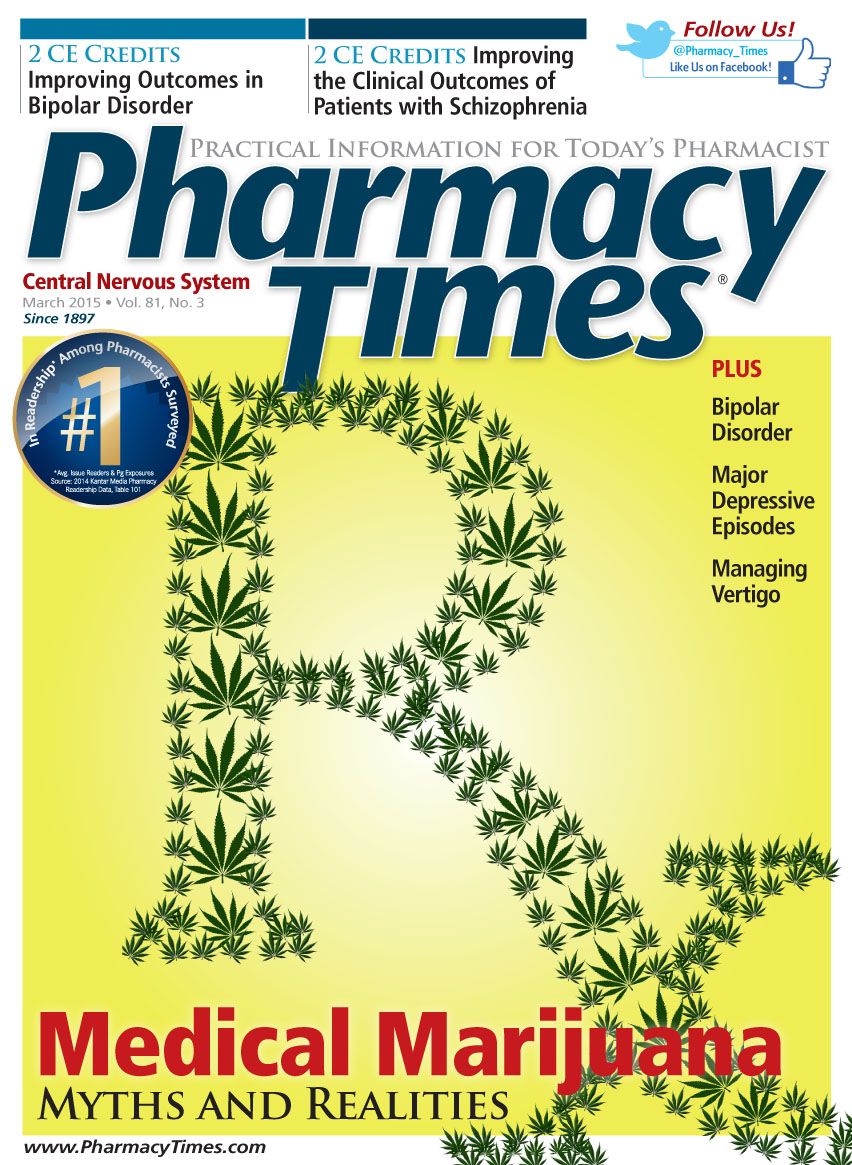Publication
Article
Pharmacy Times
Bipolar Disorder: Managing a Complex Condition
Author(s):
Bipolar disorder can be managed with a variety of FDA-approved pharmacologic treatment options.
Bipolar disorder can be managed with a variety of FDA-approved pharmacologic treatment options.
Bipolar disorder (BPD) is a disease of alternating feelings of mania and depression that is characterized by severe mood, energy, and activity level variations. Patients may also experience a mixed state of both manic and depressive symptoms. Symptoms of BPD are severe, and often affect the patient’s ability to participate in normal daily activities.1,2
BPD is not a single entity. The latest version of the Diagnostic and Statistical Manual of Mental Disorders classifies BPD into 7 main subtypes, 3 of which include bipolar I disorder, bipolar II disorder, and cyclothymic disorder. Diagnosis depends on a patient’s history of manic, hypomanic, and depressive episodes, among other criteria.1,2
Background and Comorbidities
In the community setting, the lifetime prevalence of BPD is approximately 1%,3 although estimates range from 0.5% to 4.3%.4 Patients may develop BPD at any time in life, although approximately one-half of cases manifest before 25 years of age. The cause(s) of BPD are not fully understood, but scientists believe both environmental and genetic factors play a role in its development and progression.1
BPD is associated with behavioral comorbidities, such as substance abuse disorder, and is often accompanied by other mental illnesses, such as anxiety disorder, posttraumatic stress disorder, and attention- deficit/hyperactivity disorder. Common medical comorbidities include thyroid disease, migraine headaches, heart disease, obesity, and diabetes.1 In addition, patients with BPD are at high risk for self-harm. An estimated one-fourth to one-half of patients attempt suicide, which is the cause of death in 8% to 19% of patients.5
Approved Treatments
FDA-approved treatments for BPD include mood-stabilizing drugs such as lithium salts, valproic acid, divalproex sodium, and lamotrigine. Several atypical antipsychotic medications are also approved for use in patients with BPD, including quetiapine, ziprasidone, aripiprazole, asenapine, olanzapine, and risperidone. Four of these are available as long-acting intramuscular injections (quetiapine, ziprasidone, aripiprazole, and olanzapine), and 1 atypical antipsychotic agent, olanzapine, is available in combination with the selective serotonin reuptake inhibitor (SSRI) fluoxetine. An inhaled powder form of the tetracyclic antidepressant loxapine is an approved treatment for BPD-associated agitation, but is only used in qualified health care facilities (Online Table).6-18
TABLE: FDA-APPROVED AGENTS FOR BIPOLAR DISORDER6-18
Active Ingredient
Availability
Important Considerations
Divalproex sodium
Tablets (IR, ER, and DR), capsules (IR)
Potential to cause hepatotoxicity; liver function must be monitored; increased risk for pancreatitis
Valproate sodium, valproic acid
Injection, tablet, oral solution, capsule, liquid-filled capsule, DR capsule
Potential to cause hepatotoxicity; monitor liver function; fetal risk; increased risk for pancreatitis
Lithium (as carbonate, hydroxide monohydrate, and citrate salts)
Tablets (IR and ER), capsule, and solution (hydroxide monohydrate or citrate)
Dose must be adjusted to achieve therapeutic serum levels (0.6-1.2 mEq/L); monitor for signs of lithium toxicity (diarrhea, vomiting, tremor, mild ataxia, drowsiness, or muscular weakness); monitor thyroid function (hypothyroidism and case reports of hyperthyroidism have been observed); monitor kidney function; maintain adequate fluid and salt intake due to potential for sodium depletion with lithium therapy
Lamotrigine
Tablets (IR, ER, chewable, and orally disintegrating)
Start or stop gradually unless stopping for severe AE; potential for severe, life-threatening rash, including SJS or TEN, especially with rapid dosage titration; slower dosage titration required in patients taking CBZ, PHT, PHB, PRM, or VPA
Quetiapine fumarate
Tablets (IR and ER)
Stereotypical atypical antipsychotic considerations (see below); increased risk for blood pressure variations (hypotension and hypertension); monitor eye lens every 6 months (cataracts)
Ziprasidone HCl, ziprasidone mesylate
Capsules (IR and HCl salt), injection (lyophilized powder for IM administration; mesylate salt)
Stereotypical atypical antipsychotic considerations (see below); increased risk for DRESS and QT prolongation
Aripiprazole
Tablets (IR and orally disintegrating), oral solution, injection (solution for IM administration and kit)
Stereotypical atypical antipsychotic considerations (see below)
Asenapine maleate
Tablet (sublingual)
Stereotypical atypical antipsychotic considerations (see below); increased risk for QT prolongation, syncope, hypersensitivity (including anaphylaxis and angioedema); eating and drinking should be avoided for at least 10 minutes after sublingual administration
Olanzapine, olanzapine pamoate
Tablets (IR and orally disintegrating), injection (kit and lyophilized powder for IM administration; pamoate salt)
Stereotypical atypical antipsychotic considerations (see below); increased risk for hyperprolactinemia; monitor lipid levels and fasting blood glucose level
Olanzapine and fluoxetine HCl
Capsule (IR)
Stereotypical atypical antipsychotic considerations (see below); increased risk for QT prolongation, hyperprolactinemia, hyponatremia, angle-closure glaucoma, and abnormal bleeding; use contraindicated with MAOIs, pimozide, and thioridazine
Risperidone
Tablets (IR and orally disintegrating), oral solution, injection (IM kit)
Stereotypical atypical antipsychotic considerations (see below); increased risk for hyperprolactinemia; monitor lipid levels and fasting blood glucose level
Loxapine
Aerosol (powder for inhalation)
Increased risk for bronchospasm, respiratory distress/arrest, NMS, hypotension/syncope, seizures, C/M impairment; use contraindicated in asthma/COPD; use is REMS-restricted; only administered in a REMS-enrolled health care facility for BPD-associated agitation
Adapted from references 6-18.
Key Treatment Considerations
Patients taking forms of valproic acid should be monitored for liver function abnormalities and should be aware of the signs of hepatotoxicity, which may manifest as nausea, vomiting, abdominal pain, anorexia, diarrhea, asthenia, or jaundice. The development of pancreatitis is also a concern with the use of valproic acid. Symptoms that may indicate pancreatitis include abdominal pain, nausea, vomiting, or anorexia.9,17
Patients taking lithium should undergo blood level monitoring to ensure that the level is in the appropriate therapeutic range (eg, 0.6 to 1.2 mEq/L). All patients taking lithium should be aware of the signs of lithium toxicity, which may include diarrhea, vomiting, tremor, mild ataxia, drowsiness, or muscular weakness. Because lithium is eliminated renally, kidney function should be monitored regularly, and patients should maintain adequate fluid and salt intake due to the potential for sodium depletion, particularly when treatment is initiated. Medications that affect kidney function, including OTC nonsteroidal anti-inflammatory drugs, may alter the lithium level. Hypothyroidism or (more rarely) hyperthyroidism may result from lithium treatment, so regular thyroid function monitoring is recommended, as well.10
Lamotrigine can cause a severe, potentially life-threatening rash, especially with rapid dosage titration. Patients starting or stopping lamotrigine should increase or decrease the dosage gradually; however, treatment may need to be interrupted due to a severe adverse event. Patients using valproic acid require slower dosage titration when initiating lamotrigine therapy.12
Atypical antipsychotics are associated with several common side effects. All atypical antipsychotics can cause neuroleptic malignant syndrome, tardive dyskinesia, orthostatic hypotension, seizures, increased stroke risk in the elderly, hyperglycemia, dyslipidemia, weight gain, and cognitive or motor impairment. Patients taking atypical antipsychotics should regularly undergo a complete blood count to monitor for changes in the white blood cell level. Other side effects are more often associated with specific agents. For instance, hyperprolactinemia is of particular concern with the use of risperidone and olanzapine, and chronic use of quetiapine may cause eye changes, such as cataracts.7,11-15,18
Loxapine, an inhaled powder used for management of BPD-associated agitation, may cause bronchospasm, respiratory distress, or respiratory arrest. Inhaled loxapine should only be administered in a health care facility. Importantly, its use is contraindicated in patients with lung disease.8
Guideline-Based Management
Practice guidelines for the treatment of patients with BPD have been published by the American Psychiatric Association (APA; April 2002),19 Canadian Psychiatric Association (2013),20 and the National Institute for Clinical Excellence (NICE; September 2014).21 Although guidelines vary in certain respects, some general management principles are shared by all 3 major guidelines.22
In patients with acute mixed episodes, which include features of mania and depression, the guidelines uniformly recommend the use of valproate for firstline management, followed by treatment with an atypical antipsychotic, such as olanzapine or quetiapine.19-22
The guidelines vary on the recommended treatments for first-line management of acute manic episodes. For instance, the Canadian and NICE guidelines recommend the use of the atypical antipsychotics olanzapine or risperidone, while the APA guidelines only recommend treatment with lithium or valproate.19-22 A recent critical review attempted to harmonize these guidelines by recommending initial treatment with either lithium or valproate, followed by olanzapine or risperidone as next-line treatments for acute manic episodes.22
Several options are available for initial management of an acute episode of bipolar depression in patients with BPD. Guidelines universally recommend lithium as main-line therapy for acute episodes of depression in BPD. Alternatives to lithium, which vary between guidelines, include lamotrigine alone, quetiapine alone, combination treatment with olanzapine/fluoxetine, or the addition of an SSRI to background treatment with lithium or valproate. Importantly, however, antidepressant monotherapy is not recommended for patients with BPD, as antidepressant therapy without a mood stabilizer may increase the likelihood of a patient experiencing a manic episode.19-22
Conclusion
The management of BPD is complex. Although a variety of agents are available, the use of these agents is complicated by potential side effects and drug interactions. Pharmacists can best serve patients with BPD by educating them and their caregivers on the importance of adherence and the potential side effects of therapy. BPD is a serious medical condition, but pharmacists working as part of a team of health care professionals can help patients understand and manage this challenging condition through appropriate patient counseling.
Michael R. Page earned his PharmD from the Ernest Mario School of Pharmacy at Rutgers University. He has worked as a community pharmacist at CVS Pharmacy and is currently clinical editor in clinical and scientific affairs at Pharmacy Times.
References
1. The National Institute of Mental Health (NIMH). Bipolar Disorder. http://www.nimh.nih.gov/health/topics/bipolar-disorder/index.shtml. Accessed January 2015.
2. Åojko D, Suwalska A, Rybakowski J. Bipolar and related disorders and depressive disorders in DSM-5. Psychiatr Pol. 2014;48(2):245-245.
3. King P. 2011 ICBD conference coverage: practical applications of new research in bipolar disorder. J Clin Psychiatry. 2011;72(11):e34.
4. Cerimele JM, Chwastiak LA, Dodson S, Katon WJ. The prevalence of bipolar disorder in general primary care samples: a systematic review. Gen Hosp Psychiatry. 2014;36(1):19-25.
5. Latalova K, Kamaradova D, Prasko J. Suicide in bipolar disorder: a review. Psychiatr Danub. 2014;26(2):108-114.
6. FDA. National Drug Code Directory. http://www.fda.gov/Drugs/InformationOnDrugs/ucm142438.htm. Accessed January 2015.
7. ABILIFY (aripiprazole) [package insert]. Tokyo, Japan: Otsuka Pharmaceutical Co., Ltd; 2014.
8. ADASUVE (loxapine) inhalation powder [package insert]. Horsham, PA: Teva Pharmaceuticals USA, Inc; 2013.
9. DEPAKOTE (divalproex sodium) [package insert]. North Chicago, IL: AbbVie Inc; 2015.
10. ESKALITH (lithium carbonate) [package insert]. Research Triangle Park, NC: GlaxoSmithKline; 2003.
11. GEODON (ziprasidone) [package insert]. New York, NY: Pfizer; 2014.
12. LAMICTAL (lamotrigine) [package insert]. Research Triangle Park, NC: GlaxoSmithKline; 2014.
13. SAPHRIS (asenapine) sublingual tablets [package insert]. St. Louis, MO: Forest Pharmaceuticals, Inc; 2014.
14. SEROQUEL (quetiapine fumarate) [package insert]. Wilmington, DE: AstraZeneca; 2013.
15. RISPERDAL (risperidone) [package insert]. Titusville, NJ: Janssen Pharmaceuticals, Inc; 2014.
16. SYMBYAX (olanzapine and fluoxetine) [package insert]. Indianapolis, IN: Eli Lilly and Company; 2015.
17. DEPAKENE (valproic acid) [package insert]. North Chicago, IL: AbbVie Inc; 2015.
18. ZYPREXA (olanzapine) [package insert]. Indianapolis, IN: Lilly USA, LLC; 2014.
19. American Psychiatric Association. Practice Guideline for the Treatment of Patients With Bipolar Disorder Second Edition . PsychiatryOnline.org website. http://psychiatryonline.org/pb/assets/raw/sitewide/practice_guidelines/guidelines/bipolar.pdf. Accessed January 2015.
20. Yatham LN, Kennedy SH, Parikh SV, et al. Canadian Network for Mood and Anxiety Treatments (CANMAT) and International Society for Bipolar Disorders (ISBD) collaborative update of CANMAT guidelines for the management of patients with bipolar disorder: update 2013. Bipolar Disord. 2013;15(1):1-44.
21. National Institute for Clinical Excellence. Bipolar disorder: the assessment and management of bipolar disorder in adults, children and young people in primary and secondary care. http://www.nice.org.uk/guidance/cg185. Accessed January 2015.
22. Saddichha S, Chaturvedi SK. Clinical practice guidelines in psychiatry: more confusion than clarity? A critical review and recommendation of a unified guideline. ISRN Psychiatry. 2014:828917.

Newsletter
Stay informed on drug updates, treatment guidelines, and pharmacy practice trends—subscribe to Pharmacy Times for weekly clinical insights.






